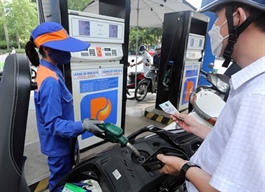Export pressure on steel groups heightens
Export pressure on steel groups heightens
When competing with China's massive output to meet the rising demand, Vietnam's steel exports are hampered.

Li Peng, purchasing director at the International Corporation of Third Construction Co. Ltd., a subsidiary of the state-owned China State Construction, said in early July that the market for sheet and section steel products in Indonesia has been quite favourable for the past few months due to the construction of factories for projects funded by Chinese companies.
China's exports of steel products rose by 41 per cent on-year during the first half of 2023, according to data from the country's Customs Administration. Local analysts predict that in 2023, the country's steel exports will reach a record 77 million tonnes, the highest seen since 2016.
The high energy costs in several nations leave steel production less competitive when compared to Chinese prices, according to Hao Pei, a senior analyst based in Shanghai. The World Steel Association reports that steel production in Asia and Oceania decreased by 6 per cent in May.
In May, steel prices reached their lowest level in three years as a result of the months-long downturn in China's real estate market.
Nguyen Quoc Hiep, chairman of the Board of Directors of Global Property Investment Corporation, shared with VIR that, "The health of Vietnam's real estate market is deteriorating, resulting in a number of construction sectors, including steel, struggling to survive."
However, unlike China, Vietnam's exports of steel remain minimal. According to the General Statistics Office, exports of steel dipped by 17.2 per cent in the first six months, reaching only $4.13 billion.
Duong Duc Quang, deputy director of the Mercantile Exchange of Vietnam, said that China accounts for about 70 per cent of the world's iron ore imports and generates more than half of the world's steel, which explains why Vietnam's steel export volume is still limited despite the sudden increase in the Chinese market.
In addition, the EU's Carbon Border Adjustment Mechanism will address commodity groupings with a higher risk of carbon leakage, such as steel. According to Dr. Dao Gia Phuc from the Institute of International and Comparative Law at the Vietnam National University in Ho Chi Minh City, this mechanism applies a fee on goods imported from countries with less rigorous emission reduction regulations, which will create obstacles for steel exports to the EU after it goes into effect on October 1.
According to the European Steel Association, the demand for steel in the EU is expected to decrease by 1 per cent in 2023, before rebounding by 5.4 per cent in 2024. This concerns steel exporters, since Vietnam's steel industry has a billion-dollar export market in the EU. In 2021, steel exports to the EU reached $1.8 billion for the first time.
However, according to Quang, Vietnam's steel exports will have advantages in the future. In particular, on June 26, the EU revised its regulations on the application of safeguard measures on certain imported steel products, with the new rules taking effect on July 1.
"As per the new regulations, as a developing World Trade Organization member, Vietnam is exempt if its exports to the EU remain below 3 per cent of total EU imports for each product type," said Quang
In addition to the EU, India will be a potential customer for Vietnamese steel exports due to the recovery of its construction industry and its policy to promote public expenditure to support steel demand, according to Vietcombank Securities analyst Vu The Duyet.
Based on to information from the Indian Steel Joint Plant Committee, Vietnam was the fifth largest supplier of steel to the Indian market between April 2021 and March 2023.
"Despite the bright spots, the overall situation of the steel export market remains precarious because short-term commercial activity is declining," Quang remarked.






















